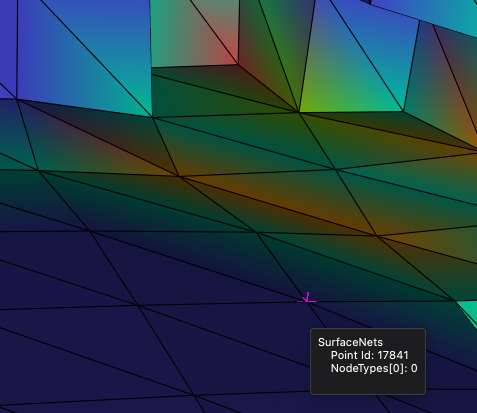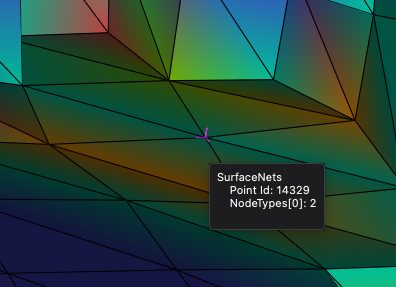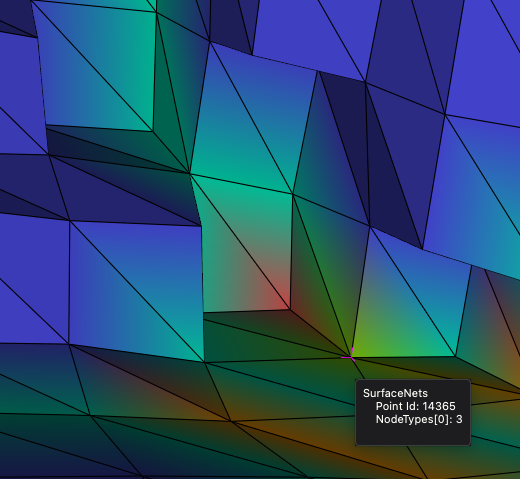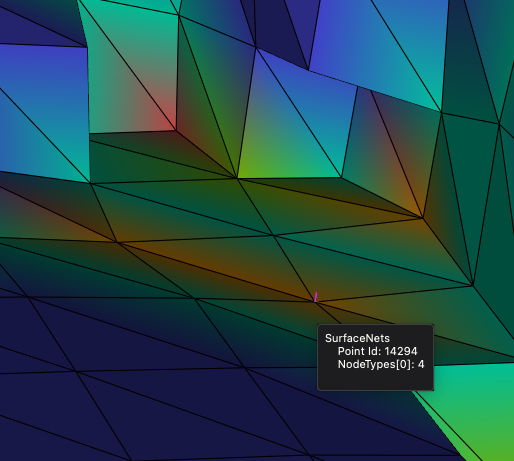8.69. Create Surface Mesh (Surface Nets)
Group (Subgroup)
Surface Meshing (Generation)
Description
This filter uses the algorithm from {1} to produce a triangle surface mesh. The code is directly based on the sample code from the paper but has been modified to work with the simplnx library classes. This filter uses a different algorithm that aims to produce a mush that keeps sharp edges while still producing a mesh superior to marching cubes or QuickMesh.
From the abstract of the paper:
We extend 3D SurfaceNets to generate surfaces of segmented 3D medical images composed
of multiple materials represented as indexed labels. Our extension generates smooth, high-
quality triangle meshes suitable for rendering and tetrahedralization, preserves topology and
sharp boundaries between materials, guarantees a user-specified accuracy, and is fast enough
that users can interactively explore the trade-off between accuracy and surface smoothness.
This filter will ensure that the smallest of the 2 FaceLabel values will always be in the first component (component[0]). This will allow assumptions made in downstream filters to continue to work correctly.
This filter attempts to repair the windings for a mesh. This may not be possible due to the nature of how meshes are stored in the software. See Verify Traingle Winding documentation for detailed breakdown of nuance.
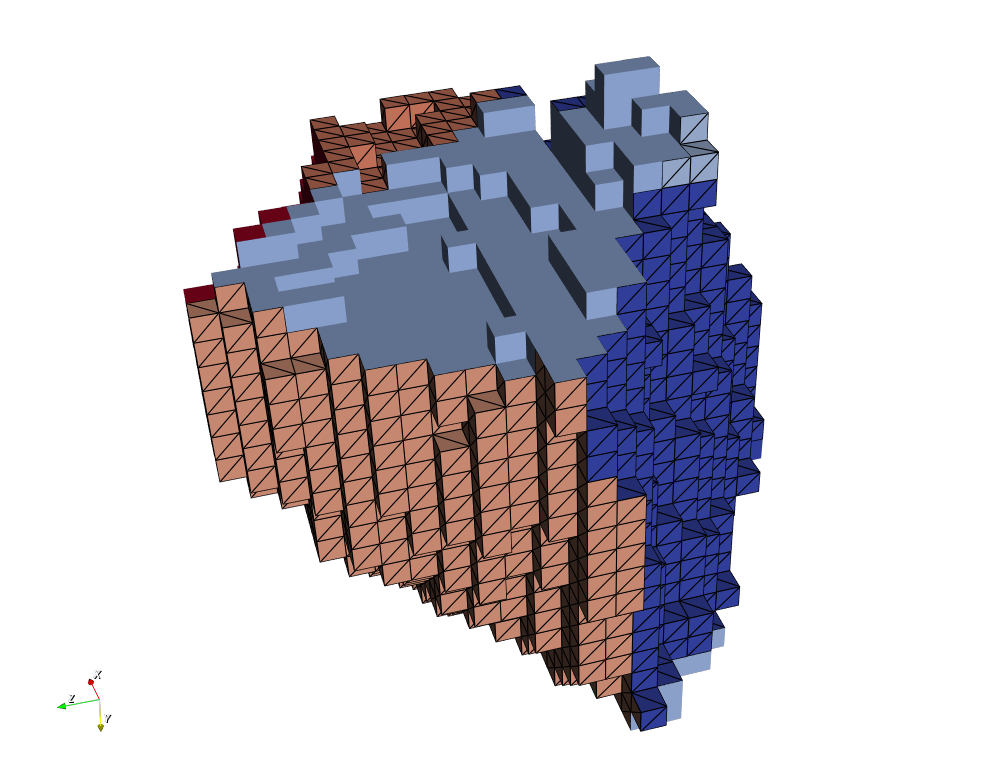
SurfaceNets without the built-in smoothing applied
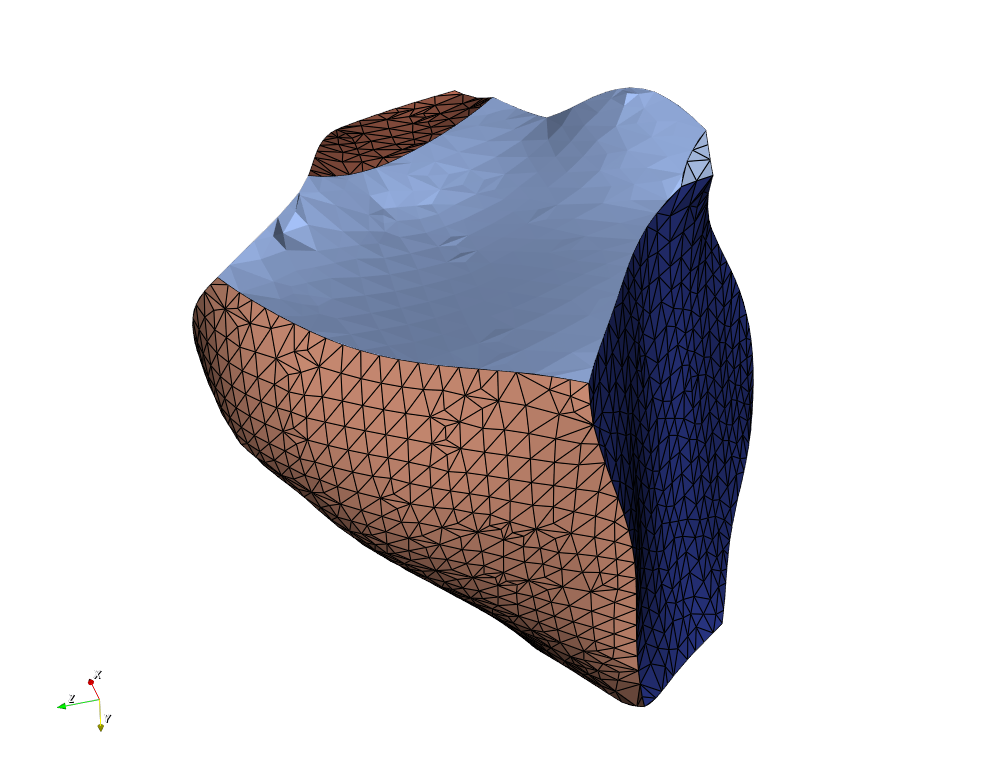
SurfaceNets output with the built-in smoothing operation applied.
Node Types
During the meshing process, each vertex, or node, will get a “Node Type” value assigned to it. These will range from 0 to 6. The value is an internal representation from the SurfaceNets algorithm. They are roughly equivelent to the Node Types from the Quick Surface Mesh algorithm but not strictly the same.
Node Type = 0: This is a node that ONLY has 2 features connected to the node.
Node Type = 2: This is a node that has 3 features connected to the node, such as a triple line
Node Type = 3-6: These nodes have 4 or more features connected to the node.
Node Type |
Example Image |
|---|---|
0 |
|
2 |
|
3 |
|
4 |
|
6 |
|
Exterior or Boundary Nodes
Nodes that appear on the exterior of a volume have Node Type values starting at 10 and going up from there. For instance, a triple line that is also on the exterior of the volume should have a value of 12.
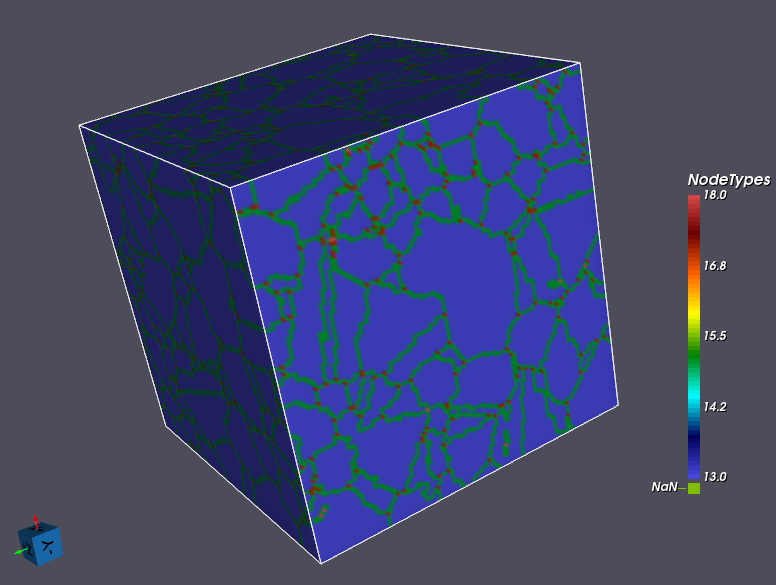
Exterior or Boundary Triangles
Each triangle that is created will have an 2 component attribute called Face Labels that represent the Feature ID on either
side of the triangle. If one of the triangles represents the border of the virtual box then one of the FaceLables will
have a value of -1.
Notes
This filter should be used in place of the “QuickMesh Surface Filter”.
Input Parameter(s)
Parameter Name |
Parameter Type |
Parameter Notes |
Description |
|---|---|---|---|
Apply smoothing operations |
Bool |
Use the built in smoothing operation. |
|
Attempt to Make Windings Consistent |
Bool |
If true, attempts to repair the windings for the mesh. This may not be possible. See help page. |
|
Relaxation Iterations |
Scalar Value |
Int32 |
Number of relaxation iterations to perform. More iterations causes more smoothing. |
Max Distance from Voxel Center |
Scalar Value |
Float32 |
The maximum allowable distance that a node can move from the voxel center |
Relaxation Factor |
Scalar Value |
Float32 |
The factor used to determine how far a node can move in each smoothing iteration |
Input Cell Data
Parameter Name |
Parameter Type |
Parameter Notes |
Description |
|---|---|---|---|
Input Image Geometry |
Geometry Selection |
Image |
DataPath to input Image Geometry |
Cell Feature Ids |
Array Selection |
Allowed Types: int32 Comp. Shape: 1 |
Specifies to which feature each cell belongs. |
Output Triangle Geometry
Parameter Name |
Parameter Type |
Parameter Notes |
Description |
|---|---|---|---|
Created Triangle Geometry |
DataGroupCreation |
The name of the created Triangle Geometry |
Output Vertex Data
Parameter Name |
Parameter Type |
Parameter Notes |
Description |
|---|---|---|---|
Vertex Data [AttributeMatrix] |
DataObjectName |
The complete path to the DataGroup where the Vertex Data of the Triangle Geometry will be created |
|
Node Type |
DataObjectName |
The complete path to the Array specifying the type of node in the Triangle Geometry |
Output Face Data
Parameter Name |
Parameter Type |
Parameter Notes |
Description |
|---|---|---|---|
Face Data [AttributeMatrix] |
DataObjectName |
The complete path to the DataGroup where the Face Data of the Triangle Geometry will be created |
|
Face Labels |
DataObjectName |
The complete path to the Array specifying which Features are on either side of each Face in the Triangle Geometry |
Output Feature Data
Parameter Name |
Parameter Type |
Parameter Notes |
Description |
|---|---|---|---|
Face Feature Data [AttributeMatrix] |
DataObjectName |
The complete path to the DataGroup where the Feature Data will be stored. |
Example Pipelines
Pipelines/SimplnxCore/SurfaceNets_Demo.d3dpipeline
Citations
{1}SurfaceNets for Multi-Label Segmentations with Preservation of Sharp Boundaries
License & Copyright
Sarah F. Frisken, SurfaceNets for Multi-Label Segmentations with Preservation of Sharp Boundaries, Journal of Computer Graphics Techniques (JCGT), vol. 11, no. 1, 34–54, 2022
http://jcgt.org/published/0011/01/03
DREAM3D-NX Mailing Lists
If you need more help with a Filter, please consider asking your question on the DREAM3D-NX Users Google group!
